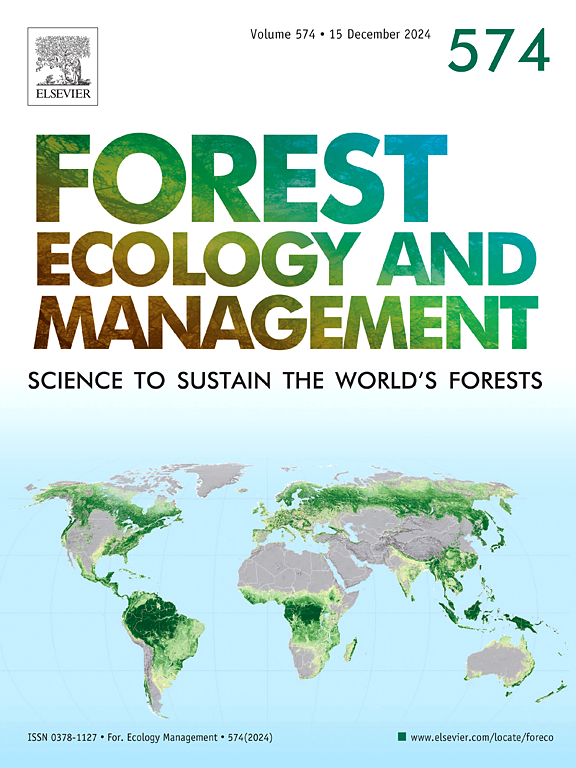Survival and growth of high-value timber species planted in Central African rainforest logging gaps
IF 3.7
2区 农林科学
Q1 FORESTRY
引用次数: 0
Abstract
Logging gaps could provide suitable conditions for enrichment plantation of timber species. However, there is little data on the long-term performance of planted species, particularly in Central Africa. In this study, we assessed the performance of 15 species planted in 198 logging gaps in a forest logging concession of South-Eastern Cameroon. A total of 2304 trees were monitored for up to 14.3 years or 19 years. We assessed the influence of species, guild, age and tree size on tree survival and growth using linear mixed-effects models. Survival rates varied across species, age and guild. Five species (Detarium macrocarpum Harms, Erythrophleum suaveolens (Guill. & Perr.) Brenan, Terminalia superba Engl. & Diels, Baillonella toxisperma Pierre and Prioria oxyphylla (Harms) Breteler) had annual survival rates greater than the average, with more than 80 % of the trees planted had survived after 14.3–19 years. On the other hand, all Entandrophragma cylindricum (Sprague) Sprague individuals had died after 14.8 years. Diameter and height growth also varied across species, age and guild. Terminalia superba had the highest diameter (16 mm.yr−1) and height (103 cm.yr−1) increments. Lovoa trichilioides Harms and B. toxisperma had diameter increments higher than 2 mm.yr−1 while E. utile, L. trichilioides, E. suaveolens, E. angolense and Mansonia altissima (A.Chev.) A.Chev. had height increments higher than 15 cm.yr−1. This study thus recommends enriching logging gaps of South-Eastern Cameroon with a pioneer species, T. superba. The use of other species (e.g., B. toxisperma, E. suaveolens and D. macrocarpum) could only be considered if maintenance can be regularly carried out.
中非雨林采伐间隙种植的高价值木材物种的生存和生长
采伐林隙可为丰富人工林提供适宜的条件。然而,关于种植物种长期表现的数据很少,特别是在中非。在这项研究中,我们评估了在喀麦隆东南部森林采伐特许权的198个采伐间隙中种植的15种树种的性能。共有2304棵树被监测了14.3年或19年。我们采用线性混合效应模型评估了树种、行规、树龄和树高对树木生存和生长的影响。存活率因物种、年龄和行会而异。五种(大角小茴香);,穗青葱)。Brenan, Terminalia superba english。,Diels、Baillonella toxisperma Pierre和Prioria oxyphylla (Harms) Breteler的年成活率高于平均值,14.3 ~ 19年成活率超过80% %。另一方面,在14.8年之后,所有的线虫个体都死亡了。直径和高度的生长也因物种、年龄和行会而异。顶草直径最大(16 mm.yr−1),高度最大(103 cm.yr−1)。三叶loloa、toxisperma的直径增量均大于2 mm。年- 1岁,而百合花、三ilioides、suaveolens、angolense和Mansonia altissima (A.Chev.)A.Chev。身高增量大于15 cm.yr−1。因此,这项研究建议用一种先锋物种T. superba来丰富喀麦隆东南部的伐木缺口。只有在能够定期进行养护的情况下,才能考虑使用其他物种(如毒虫b.s osperma, suaveolens和macrocarpum)。
本文章由计算机程序翻译,如有差异,请以英文原文为准。
求助全文
约1分钟内获得全文
求助全文
来源期刊

Forest Ecology and Management
农林科学-林学
CiteScore
7.50
自引率
10.80%
发文量
665
审稿时长
39 days
期刊介绍:
Forest Ecology and Management publishes scientific articles linking forest ecology with forest management, focusing on the application of biological, ecological and social knowledge to the management and conservation of plantations and natural forests. The scope of the journal includes all forest ecosystems of the world.
A peer-review process ensures the quality and international interest of the manuscripts accepted for publication. The journal encourages communication between scientists in disparate fields who share a common interest in ecology and forest management, bridging the gap between research workers and forest managers.
We encourage submission of papers that will have the strongest interest and value to the Journal''s international readership. Some key features of papers with strong interest include:
1. Clear connections between the ecology and management of forests;
2. Novel ideas or approaches to important challenges in forest ecology and management;
3. Studies that address a population of interest beyond the scale of single research sites, Three key points in the design of forest experiments, Forest Ecology and Management 255 (2008) 2022-2023);
4. Review Articles on timely, important topics. Authors are welcome to contact one of the editors to discuss the suitability of a potential review manuscript.
The Journal encourages proposals for special issues examining important areas of forest ecology and management. Potential guest editors should contact any of the Editors to begin discussions about topics, potential papers, and other details.
 求助内容:
求助内容: 应助结果提醒方式:
应助结果提醒方式:


